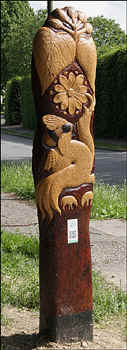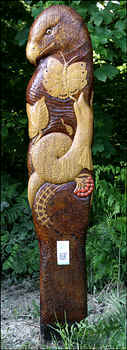|
|
ABOUT THE PLACE WAYMARKERS
marking new
CIRCULAR WALKING TRAILS in MID SUSSEX
|
|
|
|

|
|
|
|
The carved waymarker sculptures refer to the history, mythology and wildlife at
each location. The references were gathered from site visits; book and internet research;
and discussions with local people
|
|
|
|

|
|
|
|
I often represent the force of nature as a mythological creature.
Here the two legged dragon with the loop in its tail represents both the
circular walking route and the re-emergence of the natural world.
It represents a
transition from the residential and industrial parts of the villages
(whether historic or current) to the places nearby which are dominated by mud, plants and wild
creatures.
|
|
|
|

|
Lindfield Waymarker

The main theme requested was pollinators as a reference
to the meadow project
nearby.
But the village has so much history, which could not be ignored - including a significant sheep fair in medieval times (charter
granted 1343) and its name originally being Lindefeldia - place of the limes (linden trees).

|

|
|
|
|
Click on main images for enlargements -
some are still being added
|
|
|
|

|
Ansty waymarker
is in front of the new Village Centre

It is the location for a number of sports. The circle is a water wheel and
the equal cross came from the local Hussey family coat of arms. There is a
location nearby called Old Furnace and there are names of watermills also
close by
|

|
|
|
|
The most recurrent theme across all these villages was the iron industry in Sussex, dating from
before Roman times through to when coal was used in the early 1800s. Sussex
had no coal but prior to this, iron ore, fast moving streams and dense
forests close by made it ideal and very profitable for iron production.
Furnaces, hammer ponds, water wheels for both bellows and hammers, prosperity of furnace owners, charcoal burning in forests were all
elements of why these villages exist.
|
|
|
|

|
Handcross had both forest for charcoal burning and it was a staging post for carriages
between London and the south coast

Prosperous families made their homes and particularly their gardens in
the area when collections of plants like rhododendrons were being
established in England and the Japanese style was being celebrated.
High Beeches has continued to specialize in rarer plants and
currently has the national collection of naturalized gentian asclepiadia.
|

|
|
|
|
Another theme was stage coach routes and railway lines. In most
cases the railway services have since stopped and allowed villages
to become quiet locations but with significant, semi hidden history
|
|
|
|

|

Balcombe changed with the construction of the viaduct and the arrival of
the railways in the mid 1800's. Before this its forested valleys
provided charcoal and there were furnaces here to create iron.
The moon
image has long been associated with the village as it is the name of the
last remaining pub. This pub was an early haunt of the artist who
used to play the darts game 'killer' here on Friday nights.
|

|
|
|
|
Three of the waymarkers are on different parts of the Worth Way - a
disused railway route which has a new life as a footpath and cycle
track. It is being reclaimed by wildlife after its time of industry.
|
|
|
|

|
Waymarkers at Worth Way
(between Worth and Rowfant)
and Crawley Down Pond

Both celebrate the railway history as well as the wildlife to be seen
at the locations now that the trains have long gone and the only vehicles traveling
along the length are bicycles for leisure
|

|
|
|
|

|
East Grinstead
by the mainline railway station
near the Bluebell
line station
The leopard on this waymarker is an 'ounce' - the heraldic snow leopard on
the Sackville coat of arms. This family owned much land
and property in the area. Other references are to the Bluebell line
in wheels seen in the museum nearby and it was once nicknamed the primrose
and bluebell line until only the latter stuck.
|

|
|
|
|

|
West Hoathly
near Finche Field car Park

Pigs were brought here for 'pannage' ie winter feeding on acorns and beech
mast. This brought prosperity here along with the profits of the nearby
iron industry.
Lewes Priory once owned the Priest House but it passed to Henry VIII
after the reformation of the church. The Tudor rose is a reference
to this.
The Priest house and garden are full of myth and magic. There are symbols
at thresholds in this medieval hall house to protect from witches, that
were deeply believed in at the time. The plants in the garden are to
to give powers and to heal, as well as provide visual pleasure or culinary
supplies.
|

|
|
|
|
|
For all the information on the walks
you will find the brochure PDF here
|
|
|
|
|
|

|
|
|
|
|
|
Click here for pictures of the
carvings in progress -
[under construction]
|
|
|
|
|
|
|
|
|